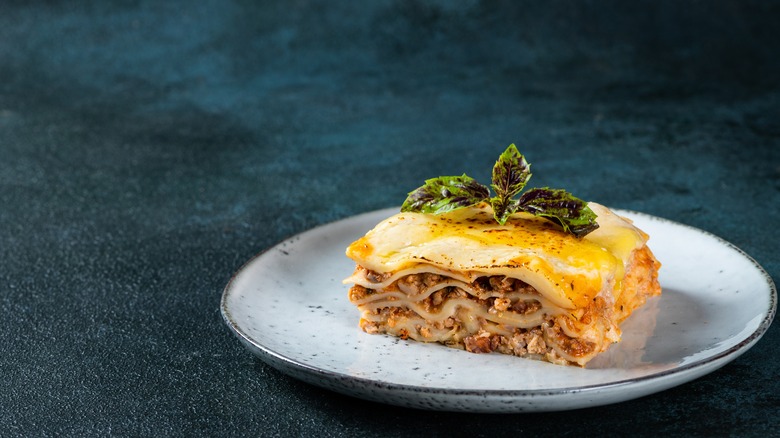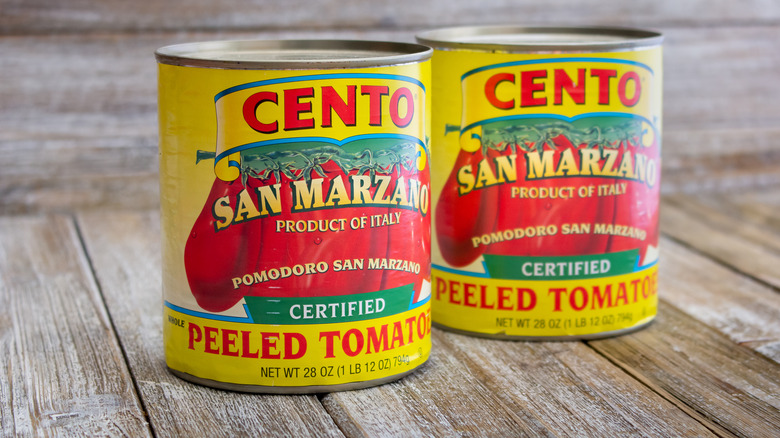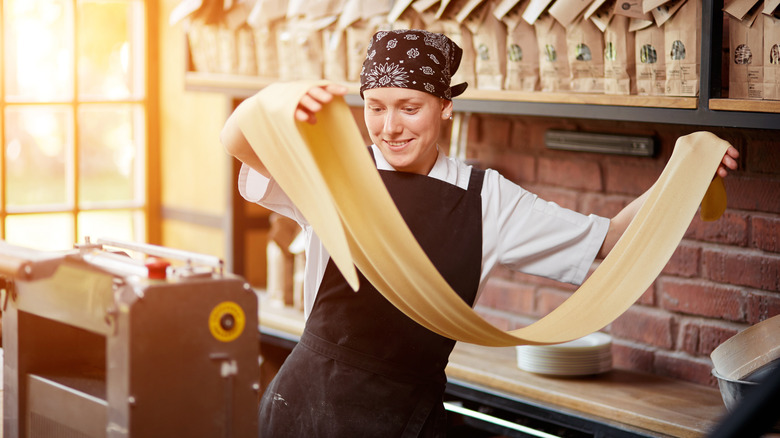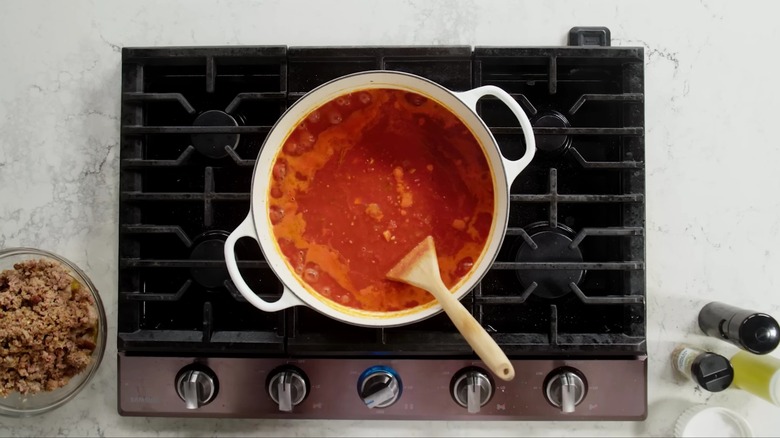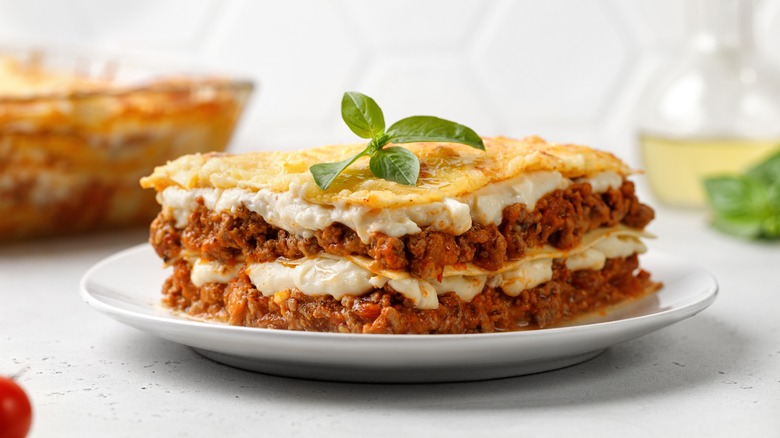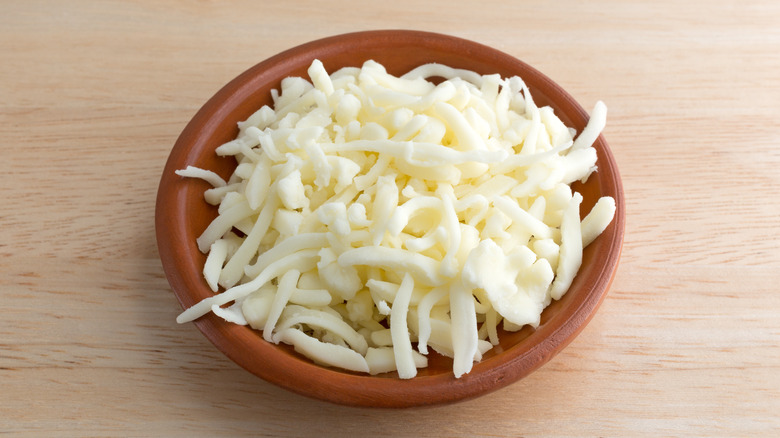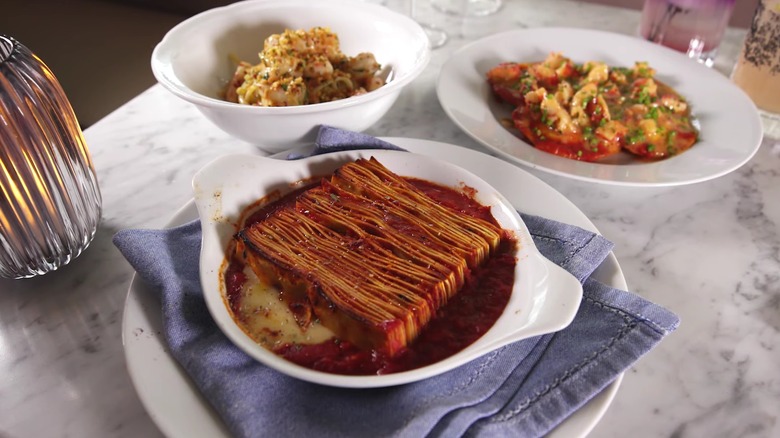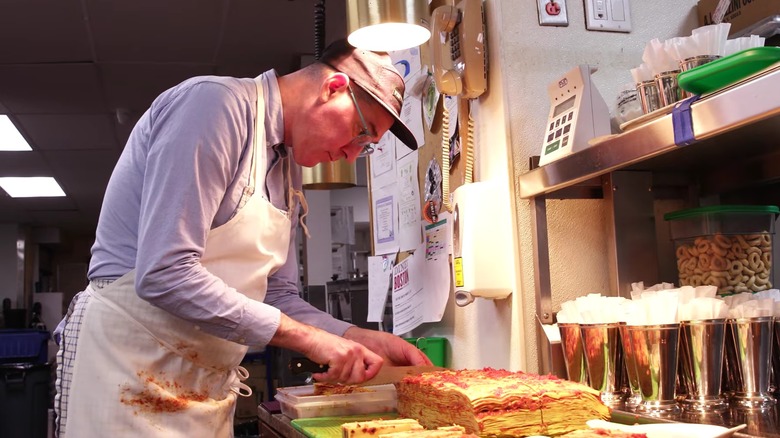9 Reasons Restaurant Lasagna Is Better Than Homemade
Lasagna is a beloved Italian dish that's eaten across the world. Hearty and comforting, this dish is often cooked at home and remains a brilliant way to satisfy an entire family. That being said, lasagna nearly always tastes better when eaten at a restaurant. In this article, we reveal why that is, examining the techniques, ingredients, and tricks that professional chefs use to upgrade their lasagna.
Lasagna is known as a dish of nearly countless variations. Aside from ensuring that there's a lasagna for every taste, this means that chefs have an incredibly free hand when it comes to interpreting the dish. Over the years, budding chefs have added ingredients and introduced new techniques, all with the goal of elevating their lasagna above the rest. The average home cook, though, couldn't expect to replicate many of these recipes due to a lack of specialist equipment or exclusive ingredients.
It's not just outlandish additions that make restaurant lasagna taste better. In fact, the quality of a lasagna generally hinges on the execution of a few fundamental steps. It's through things such as making the sauce that a professional chef's skill and attention to detail shines through. When a chef dedicates a considerable amount of time to each step, a better-tasting lasagna is the predictable result.
1. High-quality ingredients give the best flavor
As with any dish, great lasagna can only be made with great ingredients. Unfortunately, home cooks often have to make do with substandard produce as they are unable — due to cost or availability — or unwilling to purchase high-quality ingredients. Professional chefs do not face such barriers, with suppliers delivering top-notch ingredients to their kitchens every single day.
While each ingredient matters, there are some that affect the finished dish more than others. In lasagna's case, chopped tomatoes are among the most vital, as these dictate the quality of the dish's most important and flavorful component: The sauce.
When cooked, high quality canned tomatoes yield a rich, flavorful sauce that simply isn't replicable with lower-quality products. For this reason, chefs only use the best canned tomato brands when making their lasagna. Often, one person may stick with the same brand for years. In an interview with HuffPost, Boston chef Stephen Bukoff said, "I swear by Alta Cucina tomatoes. Although they are not true San Marzano tomatoes from the Campania region of Italy, they are an amazing American-grown tomato that has the perfect balance of sweetness and acidity for our culinary needs." Consequently, home cooks who make lasagna without high-quality canned tomatoes cannot expect their dish to taste as good as those made in restaurants.
2. Fresh pasta gives a better texture
Home cooks often make their lasagna with dried pasta sheets. There are many benefits to this approach: Dried pasta is cheap, readily available, and easy to use. While a sensible choice for home cooks, dried pasta does not result in the best lasagna; fresh pasta gives the dish a far superior finished texture. In an interview with Food & Wine, Massachusetts chef Danielle Glantz said, "The [fresh] pasta sheets are like silk — it's something special to share with the people you care about most." Speaking about preparing lasagna with is, she added, "Trust me — you'll never want to use boxed pasta sheets again."
Aside from improving the dish's texture, making lasagna with fresh pasta also gives chefs greater control over the dish. Professional chefs like Samin Nosrat, author of the book " Salt Fat Acid Heat," create pasta sheets that are much thinner than store-bought sheets. Their lasagna is much lighter, and contains more layers, as a result.
Fresh pasta absorbs less moisture than dried pasta. This means that chefs using fresh pasta can limit how much water they introduce into their sauce, ensuring the lasagna is as flavorful as possible. As a nice aside, less absorption also means that lasagna made with fresh pasta is less likely to become too dry or its sauce overly thick.
3. The sauce is made in-house
It is no secret that the majority of lasagna's flavor comes from the sauce. Despite this, many home cooks do not make their own, preferring instead to buy jarred sauces. The reason for this is simple: Many home cooks do not have the time to spend hours making the sauce from scratch. While there are many good jarred sauces on the market, few, if any, can compete with a fresh sauce made by a professional chef.
Chefs create uniquely flavorful sauces by employing several techniques. Firstly, meat is browned in the pan. This leaves behind an immensely flavorful mixture of melted fat and fond that provides a rich base to the sauce. Secondly, aromatics, usually onions, are sautéed in this mixture before wine, chopped tomatoes, and water are added. At this point, chefs often add further flavor by incorporating herbs, usually in the form of a bouquet garni, a highly customizable mixture of herbs. What comes next is the most important step: A long simmer. The simmering stage usually lasts for well over an hour, allowing the sauce to thicken and the ingredients to interact, developing an unrivaled flavor.
Sauce is the backbone to the dish and the time and effort a chef puts into it are obvious to anyone eating the lasagna. Given that professional chefs often dedicate hours to creating theirs, it's not difficult to see why restaurant lasagna often tastes better.
4. Restaurants use flavorful cuts of meat
The majority of simple, meat-based lasagna recipes only call for ground beef to be included in the sauce. This is fine, but professional chefs often opt to include a variety of more flavorful meats to improve the taste of their lasagna. Generally speaking, these tend to be fattier meats including the likes of Italian sausage and pork rib. Home cooks working from simple recipes that call for one type of meat, usually lean beef mince, can easily end up with lasagnas that are bland and sometimes even dry in comparison to those served at restaurants.
Chefs prefer fatty meats when cooking lasagna because they add a great deal of flavor to the sauce. During browning, the flavorful fat melts out of the meat and is subsequently used to cook the aromatics, developing an intensely meaty and savory base for the sauce. Professional chefs also like to use more than one type of meat when making lasagna. Each meat adds an extra dimension to the dish. Some chefs, including New York Times food columnist J. Kenji López-Alt, even add chicken livers to lasagna sauce, traditionally used in Bolognese sauce, to make the dish incredibly rich.
5. Béchamel sauce gives a silky smooth texture
When it comes to cheese, there are two distinct types of lasagna: Those made with ricotta and those made without. Lasagna that includes ricotta is more familiar to Americans. It's the dish many people grew up eating, is prized for its comforting nature, and is often the lasagna favored by home cooks. However, many chefs prefer to remove ricotta from the dish, making a luxuriously creamy lasagna with béchamel sauce instead.
Chefs prefer béchamel because the sauce binds the layers of pasta together and results in the dish taking on an extremely silky texture. What's more, using béchamel gives chefs the opportunity to infuse the dish with further ingredients and flavors. In an interview with SheerLuxe, chef Jack Clements said, "To take your lasagna from good to excellent, make a great béchamel sauce. Try using Davidstow five-year-old cheddar cheese as it's got such a distinctive, punchy flavour profile."
While ricotta can be flavored through the addition of salt and lemon juice, béchamel is much more receptive to additional flavorings. As such, its inclusion is a key reason why restaurant lasagnas taste better.
6. Low-moisture, strained cheeses give a better consistency
A large part of lasagna's appeal is its texture. The sauce should run without being too thin, and the pasta must be soft, not mushy. Professional chefs know this. They also know that any moisture that's added to the lasagna can disrupt the balance of the dish, diluting its flavor and ultimately ruining its delicate texture. It's for these reasons that many lasagnas served at restaurants are made with either low-moisture or strained cheeses.
Many chefs, like Frank Proto, use low-moisture mozzarella in their lasagnas. Per the United States Department of Agriculture, low-moisture mozzarella is made up of anywhere between 45% to 52% moisture, whereas regular mozzarella contains between 52% and 60% moisture. As such, lasagnas made using low-moisture mozzarella will be thicker and more flavorful than those made with regular mozzarella.
The same can be said for ricotta. While many home cooks use ricotta in their lasagna, few strain it beforehand. This is a mistake as nearly all American ricotta is much more watery than Italian versions of the cheese. If using unstrained ricotta, the lasagna may end up loose and too runny. Professional chefs are aware of this and often strain the ricotta for hours before using it. The end result is a flavorful lasagna with a delightful texture.
7. Restaurant lasagnas have many layers
It's rare for home-cooked lasagnas to be more than three or four layers thick. Often, home cooks have neither pasta thin enough nor dishes deep enough to create any more layers than this. While there's no exact number of layers a lasagna should have, many-layered lasagnas are a culinary feat that's uniquely enjoyable to eat.
An extreme example of this is chef Mark Ladner's 100 layer lasagna, a dish that was first served at Del Posto in New York City. Now served at Ladner's restaurant Bar Enza, the dish features 50 layers of fresh pasta and alternating layers of Bolognese, béchamel, and marinara sauce. Each portion is seared before serving. The finished dish is both visually striking and incredibly decadent, with paper-thin pasta layers giving way to rich sauce.
It's unreasonable to expect any home cook to produce a dish of Ladner's magnitude. The time, effort, skill, and equipment required is simply too much. Home-cooked lasagnas just can't compete with the immense multi-layered dishes crafted by professional chefs, which is one of many reasons why we still order the comforting dish when eating out.
8. It's often made the day before
Due to its time-consuming nature, many restaurants cannot make lasagna to order, even if all parts of the dish have been prepped in advance. Instead, restaurants tend to make lasagna in bulk and ahead of time, part cooking it and storing it for service. When an order comes in, a portion of the lasagna is removed from storage and finished in the oven or on the stove. While some people may turn their nose up at this practice, it actually improves the dish's overall taste.
In an interview with Forbes, food scientist Dr. Kantha Shelke explained why this is, saying, "Aromatic ingredients tend to undergo a larger number of reactions that produce flavor and aroma compounds which in turn react with the proteins and the starches. In general, as the food cools and is left to sit in the fridge, and then re-heated, some of these reactions continue to take place resulting in improved flavor." The lasagna's flavors meld together during this time, resulting in a dish that tastes incredibly well-rounded.
Making lasagna the day before also gives the dish plenty of time to rest. Chefs including Lidia Bastianich, a woman who knows a great deal about cooking pasta, recommend resting lasagna as it allows the lasagna's cheese and sauce to cool and thicken. In fact, the whole dish becomes somewhat more solid, allowing for cleaner cuts to be made and the finished dish to look better on the plate.
9. Chefs create inventive variations
The majority of home cooks stick to traditional, basic recipes when making lasagna. After all, the dish is already time-consuming to make as it is. Professional chefs, on the other hand, often serve creative variations of the dish that demonstrate their skill and knowledge. A prime example of this was the crab lasagna with beurre blanc that was served at Bistrot de Luxe in London until its closure in 2018. This dish replaced the traditional beef and tomato sauce with a light crab and scallop mousse served in a rich, buttery sauce.
Other chefs have created lasagna dishes that are suitable for those with a host of dietary requirements. These include a vegetarian and gluten-free lasagna made with celeriac and black truffles, created by Gerard Villaret Horcajo, chef at the Michelin-starred restaurant Elements, Inspired by Ciel Bleu.
Making dishes such as these at home is a difficult task. They require the sourcing of expensive and often hard-to-find ingredients as well as an impressive amount of culinary skill. It's for this reason that many home cooks stick to simple, classic lasagna recipes. While delicious, these dishes pale in comparison with leading chefs' creative takes on the dish — all the more reason to order a lasagna next time you sit down in your favorite restaurant.
